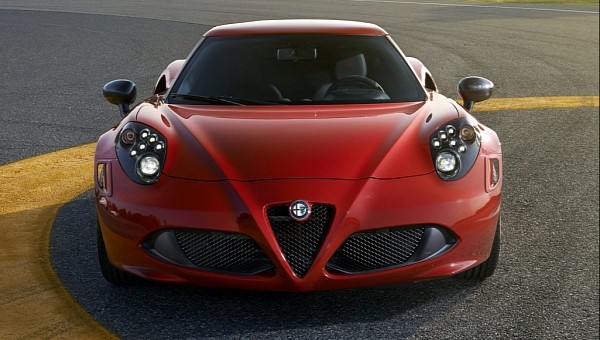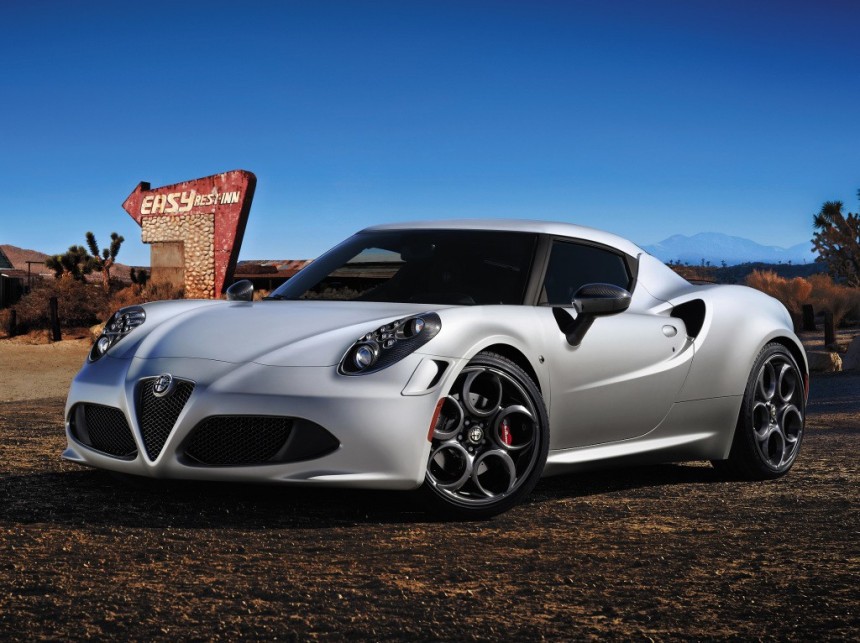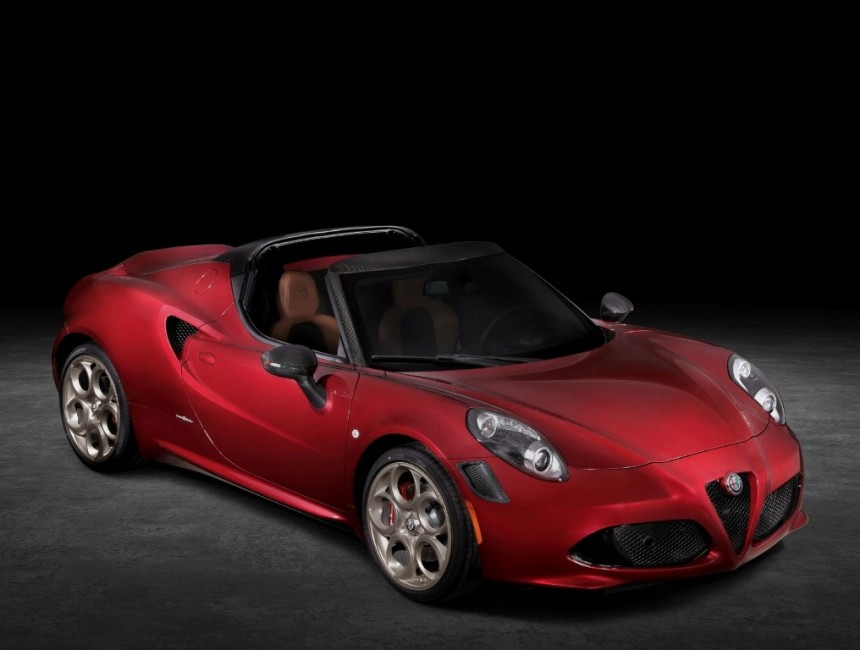Alfa Romeo had extremely high expectations of the 4C prior to its world premiere at the 2013 Geneva Motor Show. These ill-judged expectations were based on the high demand for the 8C, a Maserati-built supercar that received over 1,400 orders for the coupe alone. Only 500 were eventually produced. The 4C was projected to sell 20,000 units or thereabouts, but as you’ll find out later on, the Italian outfit was badly wrong.
Similar to the V8-engined supercar before it, the four-pot sports car was manufactured in Modena by Maserati. The Milanese-based automaker didn’t have the right expertise and tools for the 4C, which is based around a carbon-fiber tub complemented by aluminum subframes. How light? Make that 65 kilograms (143 pounds) for the tub and 107 kilograms (236 pounds) for the tub, subframes, roof reinforcements, and engine mounts.
Alfa Romeo also had financial difficulties back then, attributed to the aftermath of the financial crisis and very poor management on Fiat’s part. The Turin-based automaker continues to hinder Alfa Romeo, having canned both the 700-horsepower 8C and 600-horsepower GTV back in 2019.
Turning our attention back to the 4C, the bigwigs wanted a fabulous-looking sports car to mark the brand’s return stateside. Alfa Romeo further intended the 4C as the far more exotic alternative to entry-level sports cars from Porsche and Lotus, although the 4C failed to deliver in many respects.
For example, four screws and a protection panel have to be unscrewed and removed before adding windshield washer fluid. The 4C received plenty of criticism for not having power steering, which is essential for a road-going car of the 21st century. Regardless of how many kilograms were saved by not offering powering steering, its absence is completely unjustifiable.
The minuscule cargo area under the rear glass can’t hold more than 3.7 cubic feet (105 liters) of whatnots. Instead of a glovebox, in-car storage comes in the form of a net under the dashboard and a pouch in the center armrest. The cup holders are pretty much useless, but still, the cabin’s biggest shortcoming is the substandard quality. Prospective customers also expected unique switchgear instead of an FCA parts bin special. The parts bin also included the 1750 TBi powerplant and C635 DDCT gearbox.
Undeniably a thriller in the corners, the 4C uses a 1,742-cc engine from the Fiat Pratola Serra engine family. The first member of said family was introduced in 1994, and the 1750 TBi was mounted transversally in the 4C because it had been originally developed for the 159 compact executive sedan. Also shared with the Giulietta hatchback, Brera coupe, and Spider… uhm… spider, this lump is connected to a dual-clutch transmission shared with the Fiat, Dodge, and Jeep brands. The Milanese brand continues to employ this gearbox in the 1.6-liter turbo diesel-engined Tonale SUV.
Greatly inspired by the Tipo 33 Stradale and more contemporary 8C, the 4C had a single deficiency in terms of exterior design. The Euro-spec open headlights look completely out of place, and worse still for Centro Stile Alfa Romeo, the U.S. variant had better-looking housed units although the Xenon headlights were designed solely to comply with U.S. regulations.
Said headlights were shared with the Spider. Unveiled at the 2014 New York Auto Show for the 2015 model year, the Coupe for North America would be discontinued in 2017 due to Federal Motor Vehicle Safety Standard 226 for ejection mitigation. The Spider lived on through the 2020 model year, and it didn’t sell well either. The U.S.-spec 4C might have looked better than its European counterpart, but it was also heavier. To comply with crash regulations, Alfa Romeo included extra bracing and strengthening, which added approximately 100 kilograms (220 pounds).
The aforementioned bracing and strengthening carried over to the global-market Spider. Over in Europe, the Spider was rated at 1,015 kilograms (2,238 pounds), compared to 1,128 kilograms (2,487 pounds) for the U.S. variant. Rather than a hard top, the Spider came with a canvas roof. The matte-black or carbon-fiber rollover hoop further set it apart from the Coupe, along with cool-looking flying buttresses and a flat rear deck.
Very few updates were made during the 4C’s production cycle, most of them aesthetic in nature. Alfa Romeo had also launched quite a few special editions. The most special of the bunch is – without a shadow of a doubt – the 33 Stradale Tributo. Harking back to the 1960s supercar we all know and love, the 33 Stradale Tributo further marked the end of production.
Finished in Rosso Villa d’Este and beautified with gray-gold wheels measuring 18 inches up front and 19 inches out back, the last hurrah breathes out through a sports exhaust supplied by Akrapovic. No changes were made to the powertrain, though, meaning that the 33 Stradale Tributo cranks out 237 horsepower and 258 pound-feet (350 Nm) of torque.
Alfa Romeo initially expected to sell 3,500 units of the 4C per year, an expectation that can only be described as wishful thinking. The 4C would end production in 2020 with fewer than 9,200 units to its name. It does, however, live on in the guise of the Abarth 1000 SP Classiche. At press time, Abarth still hasn’t confirmed how many units will be produced.
Alfa Romeo also had financial difficulties back then, attributed to the aftermath of the financial crisis and very poor management on Fiat’s part. The Turin-based automaker continues to hinder Alfa Romeo, having canned both the 700-horsepower 8C and 600-horsepower GTV back in 2019.
Turning our attention back to the 4C, the bigwigs wanted a fabulous-looking sports car to mark the brand’s return stateside. Alfa Romeo further intended the 4C as the far more exotic alternative to entry-level sports cars from Porsche and Lotus, although the 4C failed to deliver in many respects.
For example, four screws and a protection panel have to be unscrewed and removed before adding windshield washer fluid. The 4C received plenty of criticism for not having power steering, which is essential for a road-going car of the 21st century. Regardless of how many kilograms were saved by not offering powering steering, its absence is completely unjustifiable.
Undeniably a thriller in the corners, the 4C uses a 1,742-cc engine from the Fiat Pratola Serra engine family. The first member of said family was introduced in 1994, and the 1750 TBi was mounted transversally in the 4C because it had been originally developed for the 159 compact executive sedan. Also shared with the Giulietta hatchback, Brera coupe, and Spider… uhm… spider, this lump is connected to a dual-clutch transmission shared with the Fiat, Dodge, and Jeep brands. The Milanese brand continues to employ this gearbox in the 1.6-liter turbo diesel-engined Tonale SUV.
Greatly inspired by the Tipo 33 Stradale and more contemporary 8C, the 4C had a single deficiency in terms of exterior design. The Euro-spec open headlights look completely out of place, and worse still for Centro Stile Alfa Romeo, the U.S. variant had better-looking housed units although the Xenon headlights were designed solely to comply with U.S. regulations.
Said headlights were shared with the Spider. Unveiled at the 2014 New York Auto Show for the 2015 model year, the Coupe for North America would be discontinued in 2017 due to Federal Motor Vehicle Safety Standard 226 for ejection mitigation. The Spider lived on through the 2020 model year, and it didn’t sell well either. The U.S.-spec 4C might have looked better than its European counterpart, but it was also heavier. To comply with crash regulations, Alfa Romeo included extra bracing and strengthening, which added approximately 100 kilograms (220 pounds).
Very few updates were made during the 4C’s production cycle, most of them aesthetic in nature. Alfa Romeo had also launched quite a few special editions. The most special of the bunch is – without a shadow of a doubt – the 33 Stradale Tributo. Harking back to the 1960s supercar we all know and love, the 33 Stradale Tributo further marked the end of production.
Finished in Rosso Villa d’Este and beautified with gray-gold wheels measuring 18 inches up front and 19 inches out back, the last hurrah breathes out through a sports exhaust supplied by Akrapovic. No changes were made to the powertrain, though, meaning that the 33 Stradale Tributo cranks out 237 horsepower and 258 pound-feet (350 Nm) of torque.
Alfa Romeo initially expected to sell 3,500 units of the 4C per year, an expectation that can only be described as wishful thinking. The 4C would end production in 2020 with fewer than 9,200 units to its name. It does, however, live on in the guise of the Abarth 1000 SP Classiche. At press time, Abarth still hasn’t confirmed how many units will be produced.





























